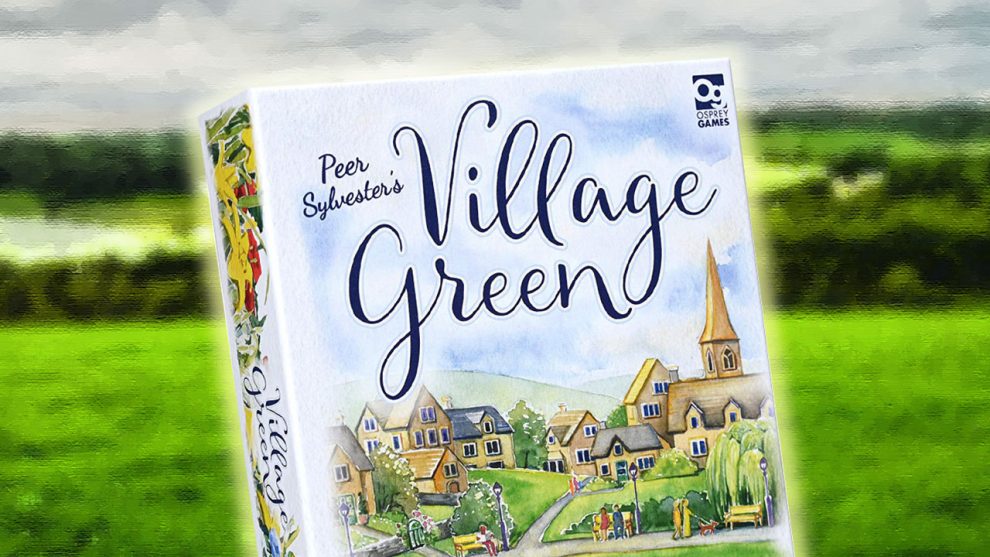Disclosure: Meeple Mountain received a free copy of this product in exchange for an honest, unbiased review. This review is not intended to be an endorsement.
In today’s tabletop environment there are lots of cardboard extroverts. You know the sort: flashy production, big boxes, attention-grabbing mechanics. They clamour for your attention on BoardGameGeek and Kickstarter, falling over themselves to show you their contents and chattering away about innovation and production. Sometimes there’s substance behind the bluster, steel skeletons to support the bombast. Sometimes, though, they’re just charismatic socialites with empty souls, a collection of coloured cardboard and little else.
At the other end of the personality spectrum lie analogue introverts, softly spoken and shrinking from attention. Small boxes, understated art, subtle mechanisms, genteel themes. Games that arrive at the party and immediately find a quiet corner out of the way. Only as you get to know them do these unassuming games reveal their actual character. Often you’ll discover that lurking within their shy boxes are steel traps poised to snap.
But enough of abusing Jung’s ideas, let’s talk about Village Green!
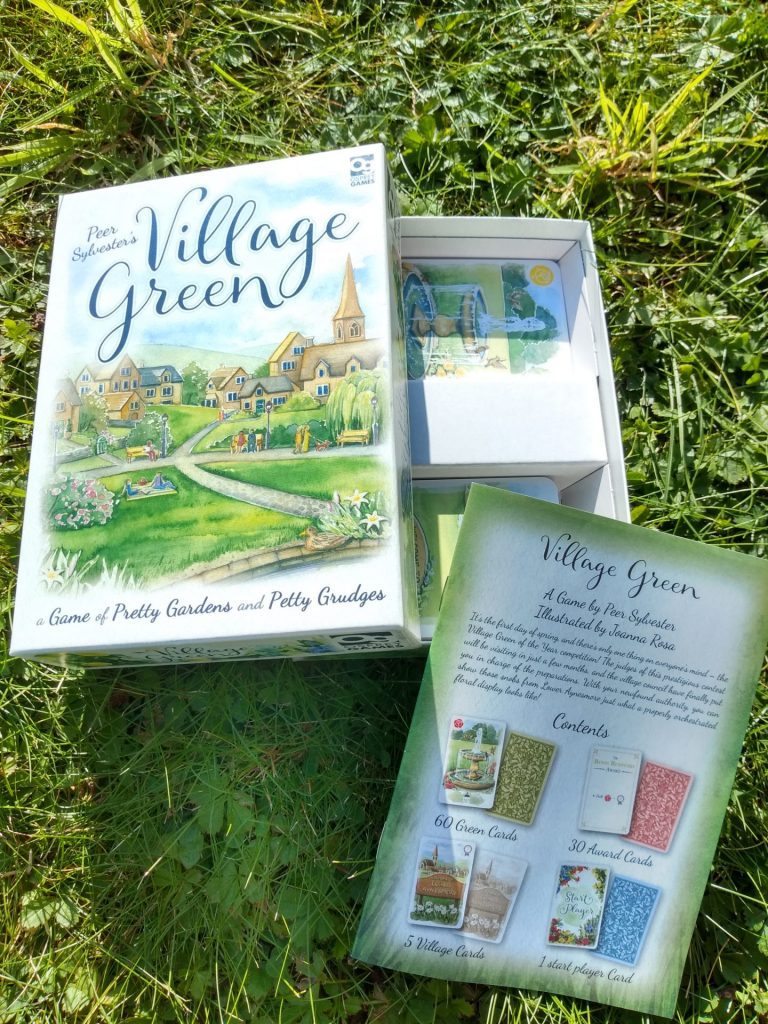
Designed by Peer Sylvester and published by Osprey Games, Village Green is a small box card game where the players are competing in the annual Village Green of the Year competition, a competition of “pretty gardens and petty grudges” according to the excellent tagline on the box.
To start, each player takes a Village card, all with fantastically English names like Market Foxby and Hither Saxcote, and places it in the top left corner of what will become their own grid of cards. Welcome to Newton Poemoor, our strict policy on littering is for the greater good.
Of course, no village is complete without its central green, so during the game you’ll be placing Green cards into a 3×3 grid, making sure that adjacent cards have matching flower types, colours or both. The floral displays need to flow naturally, no hideously contrasting blooms here thank you very much.

Green cards are available from a central market and on your turn you can select one of the three visible cards or take one from the top of the deck. When you take a Green card, you put it in your hand and then either place a Green card from your hand into your village or discard a Green card. It’s all very pleasant.
Pretty soon, though, you’ll encounter the first of Village Green’s surprisingly numerous thorns – once you’ve placed a Green card you can’t move or remove it. There are three flower types in the game (roses, petunias and lilies) and three flower colours (red, yellow and blue, although the blue comes across more as purple). You’ve only got a 3×3 grid to play with and within a couple of turns you’ll find that the once straightforward decision of where to place a Green card has become horribly tangled.
It’s a decision compounded by the presence of Village Green’s second type of card: Award cards. Award cards can be taken instead of Green cards from a similar market. Your village green is a 3×3 grid but above and to the left of it are another row and column of cards. These spaces are reserved for Award cards, meaning that you’re actually building a 4×4 grid and the Award cards… well, they’re where the game of Village Green actually lies.

You see, you can’t have competitions without prize categories and Village Green has 30 different awards up for grabs. Each Award card you play gives points depending on the three Green cards in the row beside it or the column below it. ‘The Rosie Redford Award’ offers 3 points for each red rose in the scoring row/column, whilst the ‘Award for Polychromatism’ gives 6 points if the three scoring Green cards feature a flower of each colour. There are also trickier Award cards that offer up points for some flowers but will lose you points for others.
Can you feel the puzzle building?
Each Green card scores for two Award cards – the one at the top of its column and the one at the left of its row. So you want flowers that you can legally place but that also meet the scoring requirements that you’ve been setting yourself. Everything is going swimmingly and then suddenly you’re holding a red rose knowing that the only legal place it can go would score you 3 points in the column and lose you 2 points in the row. Should you play it anyway and get that 1 point or hope to get a better card before the game ends?
Waiting for the perfect card can be a tricky gamble because, thorn alert, there’s no fixed game length. Village Green ends when a player either completes their 3×3 grid of Green cards or when one of the slim market decks of Green or Award cards runs out. So sure, you can wait but you might just find that someone else triggers the end and then you’ve got a space where you could have had 1 point. Scores aren’t huge, games can be very close and every point genuinely feels like it matters. That single point isn’t to be sniffed at.

But just as there’s more to a village green than simply flowers, there’s more to the puzzle of Village Green too.
Let’s talk about trees. Trees provide shade to sit under, a habitat for animals, something for kids to climb, sticks to fetch, leaves to kick, vertical visual texture, bark to carve a first love’s initials into, and somewhere to run to from Pemberley every day during the horse-chestnut season. All in all, trees are pretty great. Naturally, any self-respecting village wants some trees on its green, although none of those nasty coniferous ones, we don’t want their sort here.
Flowers are only one element of the Green cards, many will have one or two trees on them as well. Like the flowers, trees come in three varieties (oak, birch or willow) and, like the flowers, they can also score and lose you points via the different Award cards. For example, ‘Excellence in Trees’ will give you 1 point for each tree in the corresponding row/column, whilst the ‘Award for Outstanding Oak Plantation’ will, predictably, score you 3 points for each oak and dock you a point for each birch or willow.
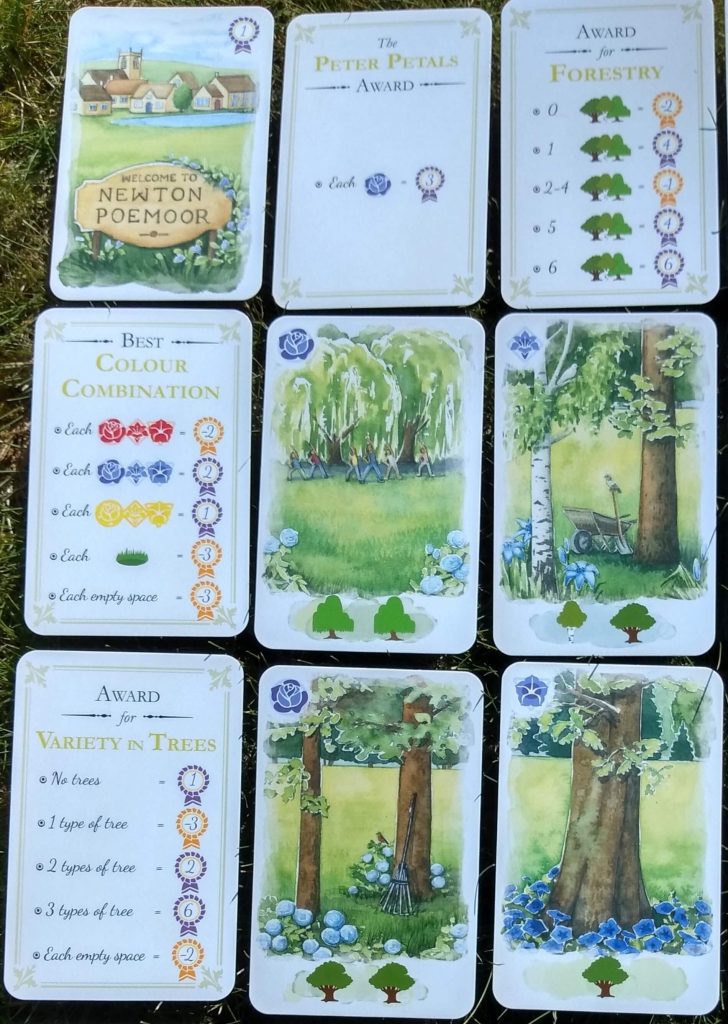
Now we’re really Greening, weighing up flowers and trees on every Green card, where it can be legally placed and which intersection of two Award cards it’ll score best for. This is so good I can almost smell the chlorophyll. Or is it the envious green of your competitors as you sneak away the card they wanted and complete a high scoring row in the process. Boom, get back to your hellhole of a hamlet you bounder!
We’ve almost uncovered all of Village Green’s personality, but here’s the thing: even a particularly pretty plant placement puzzle needs pepping for properly pleasing pizazz and panache.
Enter ponds, lawns and structures, some spicy Features with which to liven up your village green. Ponds are the most straightforward – you’ll get 2 points for each duck paradise. Quacking stuff. Lawns are flower-free, meaning you can place them anywhere you like and can even cover them up later on if you wish. Placing a structure (statues, fountains and pagodas, although the difference is aesthetic only) into your village green means you must immediately take and play an Award card. It’s a double turn if the game state is just right, but a problem if all your Award cards are already set up nicely. Crucially, all these Features feature on the Award cards, giving them meaning and substance beyond being fun bonuses to play with. They provide just enough options to liven things up without overwhelming Village Green’s core strengths.
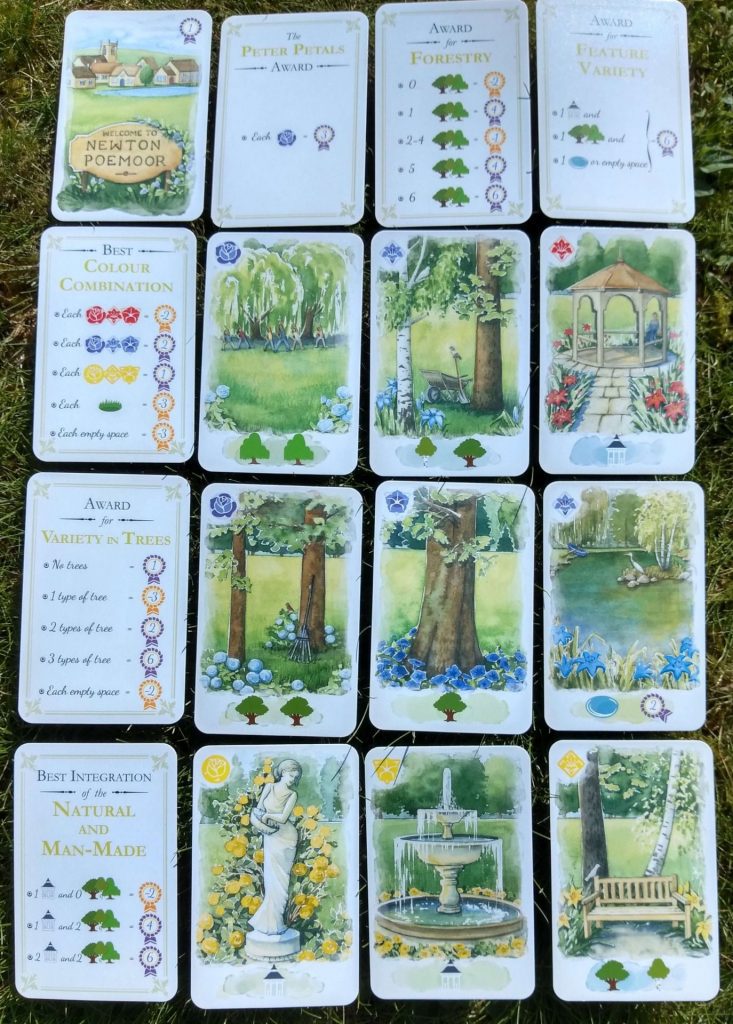
And that’s Village Green. It sounds like there’s a lot going on but really you could learn the game yourself, set everything up, teach your opponents and be playing within 10 minutes. On your turn you’ll be taking a card and possibly playing a card. After 15-30 minutes someone will trigger the end game and you’ll all total up your scores and compare.
It’s as simple, as beautiful and as thorny as a rose.
The painful pleasure of Village Green comes from tripping yourself up as you navigate the flower placement rules, intersections of Award cards and the various scoring opportunities. In the early game you’ll accidentally set yourself traps that you’ll only notice a few turns later. There is a single-use method of sacrificing 1 point to replace a Green card but otherwise your green isn’t going anywhere. Every turn you take builds on the previous ones to make a tighter and tighter puzzle, the game’s tendrils slipping unnoticed around you until you can barely move.
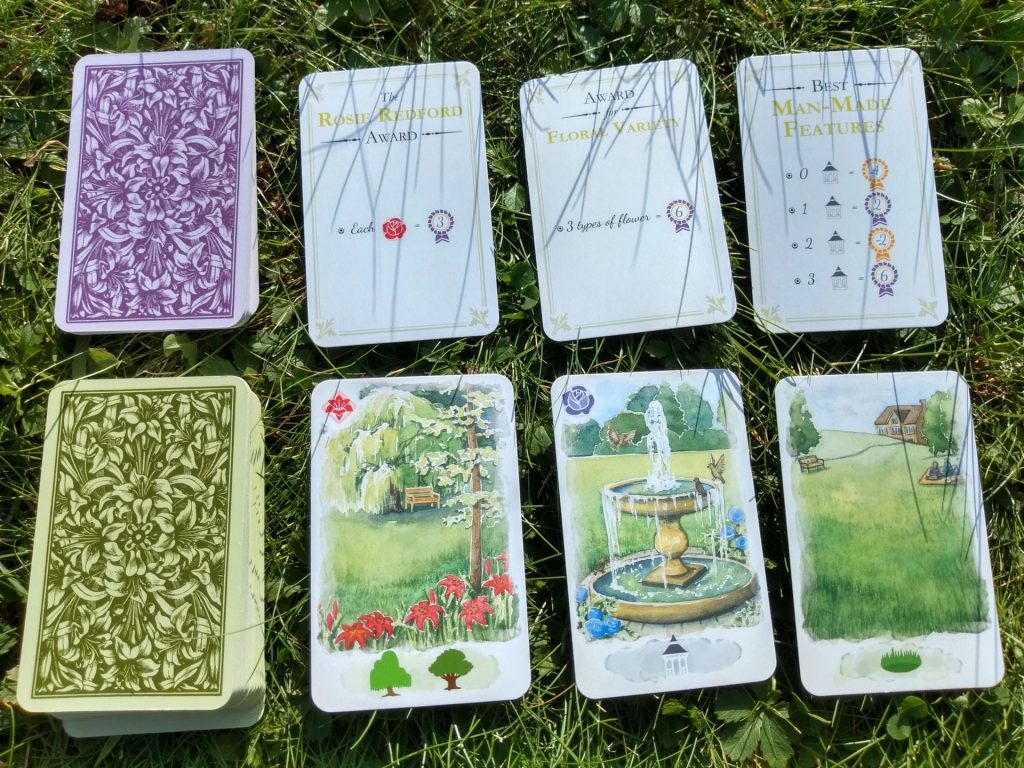
However, where some games specialise in tangling the careless player in bramble thickets, Village Green also gives you the tools to cut yourself free. Whilst you can’t replace the Green cards, you can always put a new Award card over an existing one to change the scoring criteria of an entire row or column. Sure, you made a couple of compromised decisions and ended up with a row that looks more like something those fools in Middle Didsbrook would have created, but if you just replace the existing Award card with this one you’ll triple your points. That felt good, didn’t it?
Whilst one-half of your game is fixed in place, the other half is fluid enough to allow you to pivot at just the right moment. I finished a game recently by placing a structure into my 3×3 green. It scored a positive swing of 8 points for the column and minus 2 for the row. Not bad by itself but the structure allowed me to take an Award card from the market and change the entire scoring criteria of that row, netting me an additional swing of 6 positive points. The last turn of the entire game and I gained 14 points and an enormous sense of satisfaction that was worth so much more. I won by 5 points.
Village Green reprimands you for your earlier turns whilst also letting you feel like an absolute genius when you untangle the knots you’ve created.
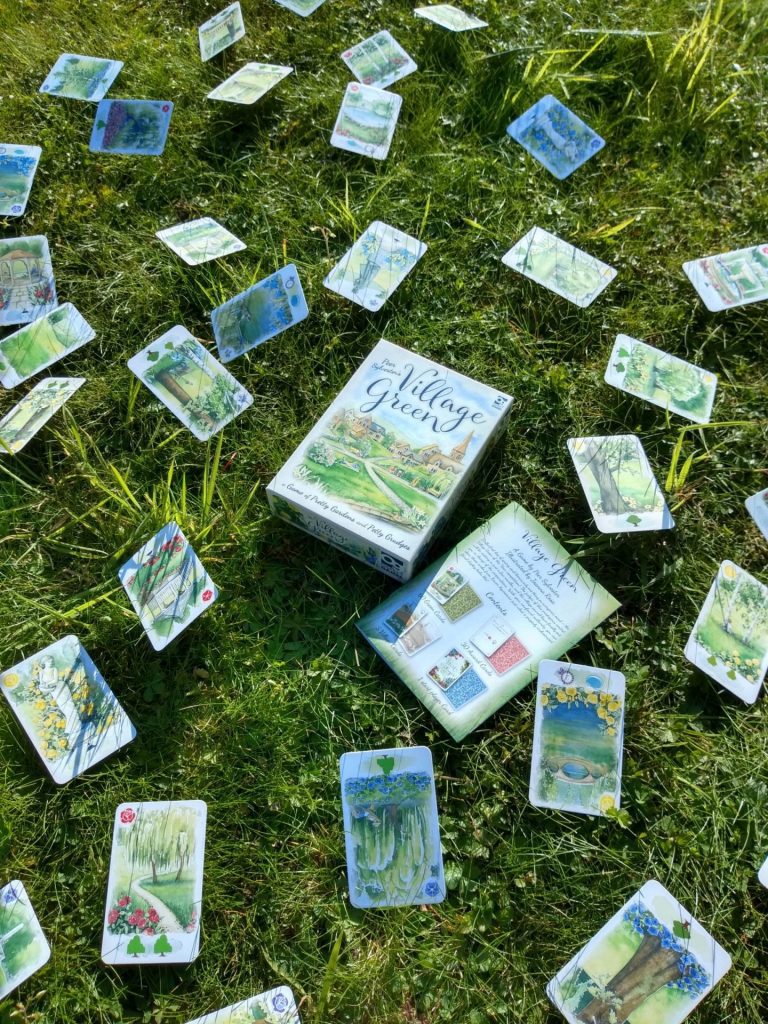
Not everything is rosy though. The tagline’s “petty grudges” promises more interaction than the game delivers: whilst you can technically take cards from the markets that you know another player will want, it’s often not worth the cost to you. Additionally, the font used on the Award cards, whilst thematically perfect, can be tricky to read upside down from across the table. At lower player counts, the turnover of the two card markets, and thus the momentum of the game itself, can be a little slow if nobody wants what’s currently available. With more players you can end up waiting a while for your turn – it’s a thinky sort of game and some people will want to really think about their moves. But, for me, the fact that Village Green plays from 1 to 5 is impressive enough to cut it some slack.
The solo game is a hard nut to crack, by the way, challenging you to get the highest score possible whilst denying you the secateurs you’d normally use to cut yourself free of your own tangles. It’s good, very puzzley but a bit too dependent on the luck of the cards. It reminds me of the classic card game Patience (Solitaire, Klondike), the sort of game where no matter how clever you are, you aren’t always going to win. Personally that doesn’t bother me and I find the solo game short enough to be an interesting challenge, but it might irritate some people.
Then there’s an issue with the clarity of the yellow flowers. The flower types are different shapes and have different shaped borders, but the petals overlap the borders which means that neither is as crisply identifiable as it should be. The contrast of white background with the dark and light shades of the red and purple flower colours is strong enough that this isn’t a problem, but with the yellow flowers it can be a bit of an issue. In good light with the three yellow flower types next to one another you can easily tell the difference, but under any other conditions you’ll find yourself double-checking cards to make sure. It’s a shame because otherwise Village Green is a gorgeous game, the watercolour artwork and Award names lush with theme, charm and wry humour.
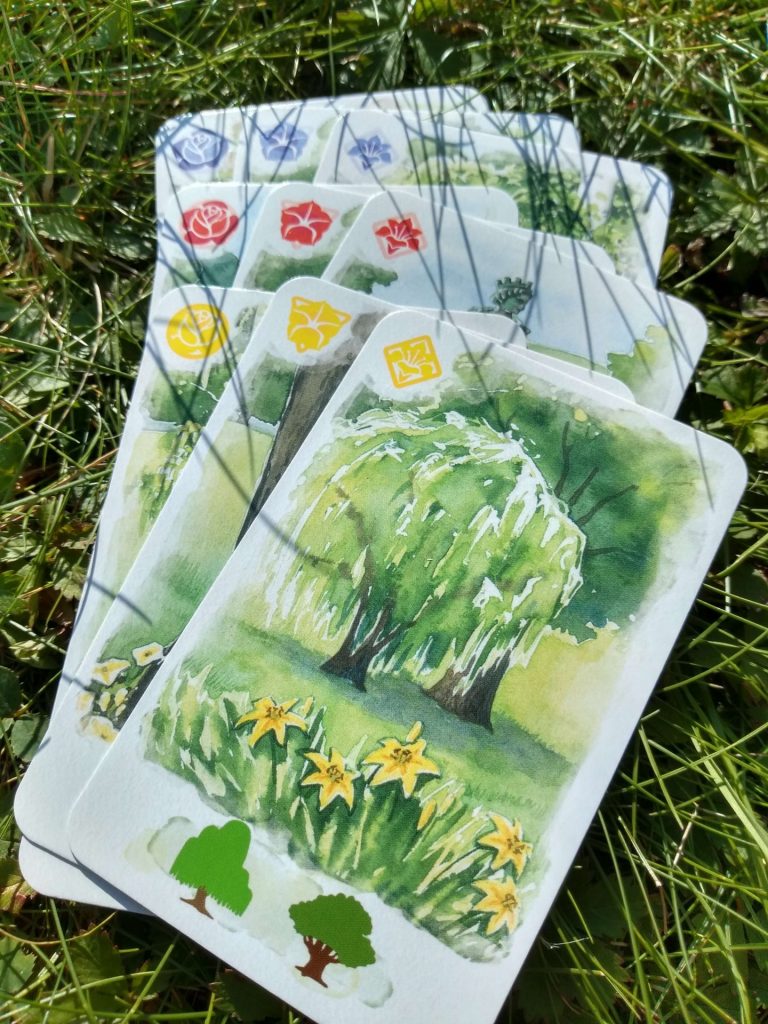
I think Village Green is the best game I’ve played all year (and I’ve played some pretty fine games for the first time this year, including Azul, Kingdomino and The Isle of Cats). It’s a box of knotty decisions, exquisite compromises and knowing when to pivot in order to maximise your points based on how the cards are falling at that time. I’ve probably thought about Village Green more whilst not playing it relative to its box size than any game I’ve played. Ever. I genuinely just want to open the box and set up a game right now. It’s not quite perfect, but for its price and the amount of space it takes up on the shelf it’s an absolute belter.
If thinky little card games or spatial puzzles aren’t your jam then I doubt Village Green will convince you otherwise. But if it sounds interesting to you then search out the quiet corner of the party where Village Green is lurking and get to know this little tabletop introvert yourself. It’ll be worth it.


